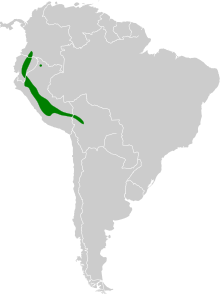Buff-tailed sicklebill
- Epimachus albertisi, a bird-of-paradise from New Guinea, is also sometimes called "buff-tailed sicklebill".
| Buff-tailed sicklebill | |
|---|---|

| |
| Scientific classification | |
| Domain: | Eukaryota |
| Kingdom: | Animalia |
| Phylum: | Chordata |
| Class: | Aves |
| Clade: | Strisores |
| Order: | Apodiformes |
| Family: | Trochilidae |
| Genus: | Eutoxeres |
| Species: | E. condamini
|
| Binomial name | |
| Eutoxeres condamini (Bourcier, 1851)
| |

| |
| Synonyms | |
|
Trochilus condamini Bourcier, 1851 | |
The buff-tailed sicklebill (Eutoxeres condamini) is a species of hermit hummingbird from the lower Andes and adjacent west Amazonian lowlands from southern Colombia and northern Ecuador to Peru and Bolivia.[3]
Description
With a total length of 5–6 in (13–15 cm) and weighing 0.28–0.44 oz (7.9–12.5 g), it is a relatively large hummingbird. Males and females are virtually identical, differing only in size (especially wing measurements), with the females being some 20% smaller.[3]
Its upperparts are
Immature birds have light-tipped
There are two
- Eutoxeres condamini condamini (Bourcier, 1851) – northern buff-tailed sicklebill
- Colombia and Ecuador. Bill longer, lower belly much streaked
- Eutoxeres condamini gracilis Stolzmann, 1902 – southern buff-tailed sicklebill
- Central Peru to Bolivia. Bill shorter, lower belly less streaked
The buff outer remiges are the most reliable trait for separating the buff-tailed sicklebill from the only other member of the
Ecology
It is restricted to the undergrowth of
The two white eggs are laid in a nest which is attached to the underside of a leaf, a few yards/meters above ground. In the southern Cordillera Oriental of Colombia, nest construction was observed in July or August, and in the lowlands of Ecuador's Napo Province in January. Birds with enlarged gonads were found in Peru from September to November. Only the female incubates; the incubation period is 16–18 days and the young fledge 22–24 days after hatching. They start to breed when they are 1–2 years old.[6]
Generally fairly common though inconspicuous and easily overlooked, it is considered a species of
Footnotes
- ^ . Retrieved 12 November 2021.
- ^ "Appendices | CITES". cites.org. Retrieved 2022-01-14.
- ^ a b c d e Hinkelmann (1999)
- ^ Hinkelmann (1999), Salaman et al. (2002)
- ^ Hinkelmann (1999), Greeney & Gelis (2007)
- ^ Hinkelmann (1999), Salaman et al. (2002), Greeney & Gelis (2007)
- ^ Hinkelmann (1999), BLI (2009)
References
- Greeney, Harold F.; Gelis, Rudolphe A. (2007). "Breeding records from the north-east Andean foothills of Ecuador". Bulletin of the British Ornithologists' Club. 127 (3): 236–241.
- Hinkelmannn, Christoph (1999): 3. Buff-tailed Sicklebill. In: del Hoyo, Josep; Elliott, Andrew & Sargatal, Jordi (eds.): ISBN 84-87334-25-3
- Salaman, Paul G.W.; Stiles, F. Gary; Bohórquez, Clara Isabel; Álvarez-R., Mauricio; Umaña, Ana María; Donegan, Thomas M. & Cuervo, Andrés M. (2002): New and noteworthy bird records from the east slope of the andes of Colombia. Caldasia 24(1): 157–189. PDF fulltext

